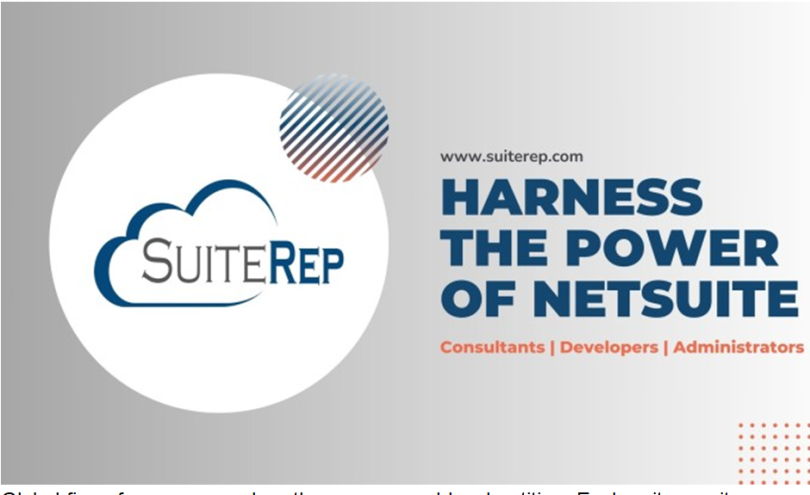Global firms face a maze when they run several legal entities. Each unit uses its own accounts, currencies, local rules, and reports. Teams wrestle with manual consolidation. They wait for files from each office. They patch data in spreadsheets. They reconcile differences line by line. NetSuite brings all units into a single cloud solution. You gain clarity, speed, and control. You free staff from grunt work. You shift focus to growth, not to data chaos.
This post covers
- Common hurdles in multi-entity operations
- NetSuite tools that unite books and reports
- Key gains in cost, time, and risk control
- Steps to launch a global setup
- Why SuiteRep stands out for NetSuite rollouts
Read on to see how you can run each subsidiary with a single source of truth.
Common Pain Points in Multi-Entity Operations
Firms with a handful of subsidiaries know these struggles all too well.
Data Silos and Delays
Each office sends its data on its own schedule. You juggle CSVs, PDFs, and email threads. You merge work in a master spreadsheet. You chase missing entries. You lose hours on simple tasks.
Currency Complexity
One entity bills in euros. Another invoices in yen. A third reports in US dollars. You apply manual rates. You adjust for gains or losses. You risk error at each step.
Local Rule Compliance
Local tax codes, filing deadlines, audit forms—all differ by region. You rely on local experts. You pay for multiple consultants. You pray that each office meets its deadline.
Intercompany Gaps
Subsidiary A sells to Subsidiary B. That sale must reflect as revenue for A and as cost for B. If either side posts wrong numbers, your books never balance. You spend days on recon.
Consolidation Headache
At month end you wait for all units to close. Then you consolidate. You adjust for elimination entries. You craft group reports. You hunt for mismatches. You delay board packs and investor updates.
NetSuite Tools that Unite Subsidiaries
NetSuite provides a suite of capabilities made to handle multi-subsidiary needs. You set up each entity in one account. You define charts of accounts per unit or share one template across all. You launch local instances in minutes.
One System for All Units
You no longer run separate ERP silos. Each subsidiary sits under one NetSuite account. You assign roles so local staff see only their data. You give global teams cross-entity view. You bypass data exports.
Automated Intercompany Transactions
NetSuite posts intercompany sales and purchases automatically. You define intercompany accounts and elimination rules once. The system creates balanced journal entries. You skip manual match and dispute loops.
Real-Time Currency Conversion
You set base currency at group level. You assign local currency per subsidiary. NetSuite fetches current rates or uses your custom values. You post transactions in local terms. You view group figures in base currency. You run gain and loss reports at any moment.
Consolidated Reports on Demand
You launch a group income statement or balance sheet with one click. You slice data by region, business unit, or product. You drill into each subsidiary’s underlying data. You avoid stale PDFs and manual merges.
Role-Based Access
Global CFO or board member sees group dashboards at a glance. Country accountants view local books and compliance checklists. Shared-service centers handle payroll across entities without seeing sensitive sales data.
Embedded Tax and Compliance
NetSuite includes local tax engines for dozens of countries. You configure VAT, GST, and withholding rules with few clicks. You produce local filing forms inside the system. You store audit trail and compliance documents in one library.
Key Gains from NetSuite Multi-Entity Rollout
When you switch from manual consolidation to NetSuite, benefits unfold across finance, operations, and governance.
- Faster Close Cycle
- Lower Overhead Cost
- Error Reduction
- Real-Time Insight
- Simplified Audit
- Quick Scaled Expansion
1. Faster Close Cycle
Teams no longer wait two or three extra days for data. You close local books instantly once entries meet approval workflows. Elimination entries post themselves. Consoliders run group close with live figures. A process that once took ten days now takes four.
2. Lower Overhead Cost
You cut the cost of spreadsheet macros and manual checks. You trim consultant fees for intercompany reconciliation. You save on extra server licenses. You use one portal for all users. Savings often reach six figures per year for mid-size firms.
3. Error Reduction
Automated currency conversion and intercompany posting eliminate common slip-ups. You see each transaction’s audit trail with user, date, and reason. You fix mismatches in minutes rather than days. You build trust in your numbers.
4. Real-Time Insight
Global dashboards show revenue by unit, region, or product line. You track cash balances across banks. You measure working capital at the group level. You spot underperforming units immediately. You launch corrective actions fast.
5. Simplified Audit
Auditors access reports and transaction logs inside NetSuite. They follow a clear path from consolidated figures to source entries. They validate controls, role permissions, and approval chains without a paper chase. You close audit in record time.
6. Quick Scaled Expansion
Need to add a new legal entity in Latin America or Asia? You copy an existing subsidiary template. You set up local tax rules. You assign users. NetSuite‘s cloud design means you can go live in weeks rather than months.
Steps to Launch NetSuite for Multi-Entity Use
A clear path helps you avoid traps and delays. These steps form a proven blueprint.
- Map Your Entity Structure
- Define Chart of Accounts Strategy
- Configure Intercompany Rules
- Set Currency and Rate Workflows
- Build Consolidated Reports and Dashboards
- Test with Sample Transactions
- Train Local and Global Teams
- Go Live and Monitor
1. Map Your Entity Structure
List each legal entity, its currency, and local tax requirements. Note any shared-service centers. Clarify reporting line for each unit.
2. Define Chart of Accounts Strategy
Choose to share one global chart or maintain local charts mapped to a unified template. Align account types and segments for easy consolidation.
3. Configure Intercompany Rules
Set up intercompany accounts and elimination rules. Detail how NetSuite should post reciprocal entries. Define auto-match criteria.
4. Set Currency and Rate Workflows
Decide when FX rates update. Use central bank feeds or custom values. Choose your revaluation schedule and automate it.
5. Build Consolidated Reports and Dashboards
Design group-level P&L, balance sheet, and cash flow. Add visual dashboards for key metrics. Embed drill paths to local entity data.
6. Test with Sample Transactions
Run pilot entries for sales, purchases, intercompany, and currency revaluation. Confirm that local books close and that group reports balance.
7. Train Local and Global Teams
Hold role-based sessions. Show local staff their ledger, their compliance tasks. Show global teams consolidated reports and audit tools.
8. Go Live and Monitor
Move into production. Keep parallel runs for a brief period if needed. Track system use, adjust workflows, update training materials as you go.
Why Choose SuiteRep for NetSuite Implementation?
Your NetSuite implementationcan determine success or failure. You need a partner that blends technical skill with industry know-how.
- Consultants with deep global finance and operations expertise
- A proven method that maps your entity web then builds each piece in phases
- Prebuilt templates for charts of accounts, intercompany rules, and compliance forms
- Workshops that equip your local and global teams with confident skills
- On-call support centers across time zones
SuiteRep ensures a swift, smooth launch. You avoid common traps and you unlock ROI fast. You gain a NetSuite implementation partner who keeps your system aligned as you add new markets, new lines, or new entities.
Your Next Move
You now see how NetSuite turns a complex multi-entity network into a unified system. You know the steps you must take. You know the gains you can win. The path to clarity, speed, and cost control lies ahead.
Reach out to SuiteRep. We’ll review your entity map. We’ll sketch a tailored rollout plan. We’ll show you live demos of global consolidation and intercompany automation. Let’s bring your books into one source of truth. Take control of your multi-entity world now.







